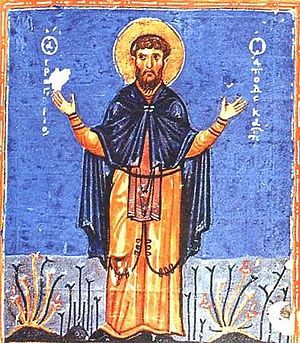In order to avoid the marriage which his parents had intended for him, he secretly left home. He spent all his life wandering: he was in Constantinople, Rome, Corinth, and he lived as an ascetic on Olympus for a while. Saint Gregory preached the Word of God everywhere, denouncing the Iconoclast heresy, strengthening the faith and fortitude of the Orthodox, whom the heretics in those times oppressed, tortured and imprisoned.
Life & Faith
An Online Orthodox Catechism adopted from ‘The Mystery of Faith’ by Bishop Hilarion Alfeyev
HOW TO EXPLAIN THE MYSTERY OF THE HOLY TRINITY?
One of the simplest ways of explaining the mystery of the Trinity is that reportedly given by St Spyridon of Trimithund at the Council of Nicaea (AD 325). According to tradition, when asked how it is that Three can simultaneously be One, St Spyridon responded by taking up a brick and squeezing it. From the soft clay in his hands a flame showed up while simultaneously water flowed downwards. ‘As there is fire and water in this brick’, said St Spyridon, ‘in the same way there are three Persons in the one Godhead’.
St. Gabriel, Serbian Patriatrch
Gavrilo I Rajić (died 1659) was Archbishop of Peć and Serbian Patriarch between 1648 and 1655. He was murdered by Turks and therefore celebrated by Eastern Orthodox Church as Hieromartyr. His feast day is celebrated on December 13.
Spyridon the Wonderworker of Trymithous
Spyridon, the God-bearing Father of the Church, the great defender of Corfu and the boast of all the Orthodox, had Cyprus as his homeland. He was simple in manner and humble of heart, and was a shepherd of sheep. When he was joined to a wife, he begat of her a daughter whom they named Irene. After his wife's departure from this life, he was appointed Bishop of Trimythus, and thus he became also a shepherd of rational sheep. When the First Ecumenical Council was assembled in Nicaea, he also was present, and by means of his most simple words stopped the mouths of the Arians who were wise in their own conceit. By the divine grace which dwelt in him, he wrought such great wonders that he received the surname 'Wonderworker." So it is that, having tended his flock piously and in a manner pleasing to God, he reposed in the Lord about the year 350, leaving to his country his sacred relics as a consolation and source of healing for the faithful.
The Conception by Saint Anna, of "Whence is Conceived the Holy Mother of God"Commemorated on December 9/22
The Conception by Saint Anna, of "Whence is Conceived the Holy Mother of God": Saint Anna, the mother of the MostHoly Mother of God, was the youngest daughter of the priest Nathan from Bethlehem, descended from the tribe of Levi. She entered into marriage with Saint Joakim (their mutual memory is made 9 September), who was a native of Galilee. For a long time Saint Anna was childless, but after a span of some 20 years, through the fervent prayer of both spouses, an Angel of the Lord announced to them the Conception of a Daughter, Who would bring blessing to all the human race. The Conception by Saint Anna took place at Jerusalem, where also was born the Most Holy Virgin Mary by name. The majority of icons, dedicated to the Conception by Saint Anna, portray the MostHoly Virgin trampling underfoot the serpent. "Down the icon, along its sides, Saints Joakim and Anna are depicted usually with upraised hands prayerfully folded; their eyes also are directed upward and hey contemplate the Mother of God, Who as it were soars in the air with outstretched hands; under Her feet is portrayed an orb wound round with a serpent symbolizing the devil, which in the face of fallen forefathers strives to conquer with its power all the universe".
An Online Orthodox Catechism adopted from ‘The Mystery of Faith’ by Bishop Hilarion Alfeyev
 ‘FATHER’ AS A DIVINE NAME
‘FATHER’ AS A DIVINE NAME
Male imagery was not therefore imposed on God, rather God Himself chose it in His revelation to humans (cf. 2 Sam.7:14; 1 Chron.17:13; Jer.3:19; 31:9). The three Persons of the Holy Trinity bear the names Father, Son and Holy Spirit, where the name Son belongs to the eternal Logos of God,Who was incarnate and became man.
In Semitic languages where the word for Spirit (Hebrew ruah, Syriac ruha) is feminine, female imagery is applied to the Holy Spirit. Both the Hebrew and the Greek terms for the Wisdom of God (Hebrew hokhma, Greek sophia) are feminine: this opens the possibility of applying female imagery to the Son of God, Who is traditionally identified with the Wisdom. With this exception, for both Father and Son exclusively male imagery is used in the Eastern tradition.
The Orthodox normally oppose modern attempts to change traditional biblical imagery by making God-language more ‘inclusive’ and referring to God as ‘mother’, and to His Son as ‘daughter’, or using the generic terms ‘parent’ and ‘child’. For the Orthodox, the full understanding of motherhood is embodied in the person of the Mother of God, whose veneration is not merely a custom or cultural phenomenon, but a church dogma and an essential part of spirituality.
Venerable Gregory Decapolite
 Commemorated on November 20
Commemorated on November 20
Saint Gregory the Decapolite was born in the Isaurian city of Decapolis (ten cities) in the eighth century. From his childhood, he loved the temple of God and church services. He read the Holy Scripture constantly and with reverence.

